
Morchella, the true morels, is a genus of edible sac fungi closely related to anatomically simpler cup fungi in the order Pezizales. These distinctive fungi have a honeycomb appearance due to the network of ridges with pits composing their caps. Morels are prized by gourmet cooks, particularly in Catalan and French cuisine, but can be toxic if consumed raw or undercooked. Due to difficulties in cultivation, commercial harvesting of wild morels has become a multimillion-dollar industry in the temperate Northern Hemisphere, in particular North America, Turkey, China, the Himalayas, India, and Pakistan where these highly prized fungi are found in abundance.

Morchella esculenta is a species of fungus in the family Morchellaceae of the Ascomycota. It is one of the most readily recognized of all the edible mushrooms and highly sought after. Each fruit body begins as a tightly compressed, grayish sponge with lighter ridges, and expands to form a large yellowish sponge with large pits and ridges raised on a large white stem. The pitted yellow-brown caps measure 2–7 centimetres broad by 2–10 cm (1–4 in) tall, and are fused to the stem at its lower margin, forming a continuous hollow. The pits are rounded and irregularly arranged. The hollow stem is typically 2–9 cm long by 2–5 cm (1–2 in) thick, and white to yellow. The fungus fruits under hardwoods and conifers during a short period in the spring, depending on the weather, and is also associated with old orchards, woods and disturbed grounds.

Paragyromitra infula, commonly known as the hooded false morel or the elfin saddle, is a species of fungus in the family Discinaceae. The dark reddish-brown caps of the fruit bodies develop a characteristic saddle-shape in maturity, and the ends of both saddle lobes are drawn out to sharp tips that project above the level of the fruit body. The stipe is white or flushed pale brown, smooth on the outside, but hollow with some chambers inside.

Gyromitra caroliniana, known commonly as the Carolina false morel or big red, is an ascomycete fungus of the genus Gyromitra, within the Pezizales group of fungi. It is found in hardwood forests of the southeastern United States, where it fruits in early spring soon after snowmelt.
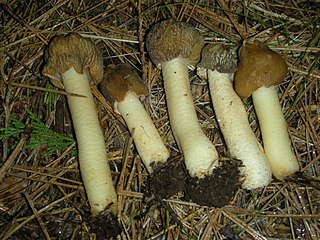
Verpa conica, commonly known as the bell morel or the early morel, is a species of fungus in the family Morchellaceae. Sometimes mistaken for a true morel, this species is characterized by a cap resembling a thimble that is freely attached to the stipe.

Verpa bohemica is a species of fungus in the family Morchellaceae. The synonym Ptychoverpa bohemica is often used by European mycologists and it is commonly known as the early morel or the wrinkled thimble-cap. The mushroom has a pale yellow or brown thimble-shaped cap—2 to 4 cm in diameter by 2 to 5 cm long—that has a surface wrinkled and ribbed with brain-like convolutions. A feature distinguishing the species from true morels, the cap hangs free from the top of the stem, which is lighter in color, brittle, and up to 12 cm long by 1 to 2.5 cm thick. Microscopically, the mushroom is distinguished by its large spores, typically 60–80 by 15–18 µm, and the presence of only two spores per ascus.

Morchella rufobrunnea, commonly known as the blushing morel, is a species of ascomycete fungus in the family Morchellaceae. A choice edible species, the fungus was described as new to science in 1998 by mycologists Gastón Guzmán and Fidel Tapia from collections made in Veracruz, Mexico. Its distribution was later revealed to be far more widespread after several DNA studies suggested that it is also present in the West Coast of the United States, Israel, Australia, Cyprus, Malta and Switzerland.
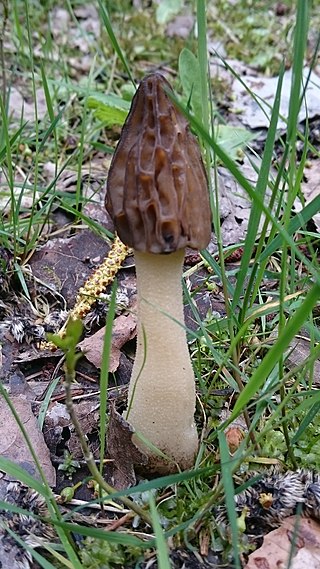
Morchella semilibera, commonly called the half-free morel, is an edible species of fungus in the family Morchellaceae native to Europe and Asia.
Lactarius torminosulus is a member of the large milk-cap genus Lactarius, in the order Russulales. A European species, it was officially described in 1996 from collections made in Norway. Fruit bodies (mushrooms) are small to medium-sized, yellowish orange in colour. Young specimens have a hairy cap margin; these hairs slough off in maturity—a field characteristic that can be used to help distinguish this species from the similar Lactarius torminosus. The fungus grows in a mycorrhizal association with dwarf birch species.

Morchella tridentina is a cosmopolitan species of ascomycete fungus in the family Morchellaceae. Commonly referred to as the mountain blond or western blond morel in North America, it produces conical, grey to buff fruit bodies that are rufescent and grow up to 20 cm (7.9 in) tall and 5 cm (2.0 in) wide. This early-diverging species is distinct within the /Elata clade due to its pale colours and has been described by many names in the past, including M. frustrata, M. quercus-ilicis, M. elatoides, M. elatoides var. elegans and M. conica var. pseudoeximia, all of which were shown to be synonyms. A widely distributed relict of the last Ice Age, M. tridentina is so far known from Argentina, Armenia, Chile, Cyprus, France, India, Israel, North America, Spain and Turkey.

Morchella americana is a North American species of fungus in the family Morchellaceae.
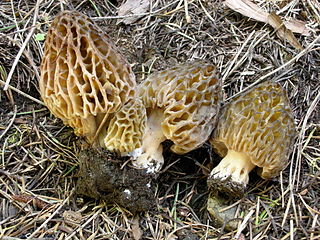
Morchella snyderi is a species of fungus in the family Morchellaceae. Described as new to science in 2012, it occurs in the montane forests of western North America, including California, Idaho, Montana, Oregon and Washington. It produces fruit bodies up to 14 cm (5.5 in) tall with ridged and pitted conical caps, and stipes that become pitted in maturity. The color of the morel is yellow to tan when young, but the cap ridges become brown to black in maturity or when dried.

Morchella importuna is a species of fungus in the family Morchellaceae described from North America in 2012. It occurs in gardens, woodchip beds, and other urban settings of northern California and the Pacific Northwest region of the United States and Canada. The fungus has also been reported from Turkey, Spain, France, Switzerland, Canada and China, although it is unknown whether this is a result of accidental introductions. It is considered a choice edible mushroom. The fruit bodies develop a distinctive ladder-like pattern of pits and ridges on the surface of their conical caps.
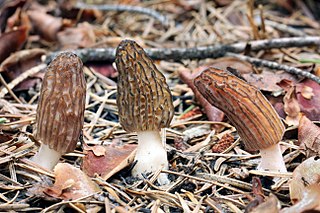
Morchella sextelata is a species of ascomycete fungus in the family Morchellaceae. Described as new to science in 2012, it is found in North America. It has also been found in China, although it is not known if this is a result of an accidental introduction or natural dispersion. The fruit bodies have a roughly conical cap up to 7.5 cm (3 in) tall and 5 cm (2 in) wide, with a surface of mostly vertically arranged pits. The cap is initially yellowish to brownish, but it darkens to become almost black in maturity. The stipe is white and hollow, measuring 2–5 cm (0.8–2.0 in) high by 1–2.2 cm (0.4–0.9 in) wide.

Morchella punctipes is a species of morel fungus in the family Morchellaceae. It is native to North America, found widely distributed east of the Rocky Mountains. It is edible when cooked.
Morchella deqinensis is a species of fungus in the family Morchellaceae found in China. It grows in coniferous and mixed forests at an elevation of 2,800–3,200 m (9,200–10,500 ft).
Morchella meiliensis is a species of fungus in the family Morchellaceae native to China.

Pholiota nubigena, commonly known as the gastroid pholiota or the bubble gum fungus, is a species of secotioid fungus in the family Strophariaceae. It is found in mountainous areas of the western United States, where it grows on rotting conifer wood, often fir logs. It fruits in spring, often under snow, and early summer toward the end of the snowmelt period in high mountain forests. Fruit bodies appear similar to unopened mushrooms, measuring 1–4 centimetres tall with 1–2.4 cm diameter caps that are whitish to brownish. They have a short but distinct whitish stipe that extend through the internal spore mass (gleba) of the fruit body into the cap. The gleba consists of irregular chambers made of contorted gills that are brownish in color. A whitish, cottony partial veil is present in young specimens, but it often disappears in age and does not leave a ring on the stipe.

Morchella arbutiphila is a species of fungus in the family Morchellaceae (Ascomycota), described from the island of Cyprus in 2016. The species is notable for its elongated stipe, which is often longer than the cap's length, its ascospores which are larger than most other species of Morchella, and its highly specific ecological preferences. It is known only from igneous substrates of the Troodos mountains in Cyprus and from a single collection in the Aegean region of Turkey.
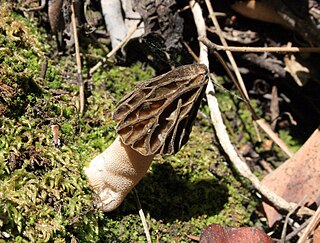
Morchella disparilis is an Ascomycete fungus in the family Morchellaceae. Described as new to science in 2016, M. disparilis appears to be confined to the Mediterranean basin and is so far known from Cyprus, Greece and Spain. Its most striking feature is the exceptionally deep sinus, intermediate in depth between half-free morels of the Morchella semilibera clade and typical Distantes species.




















